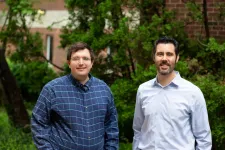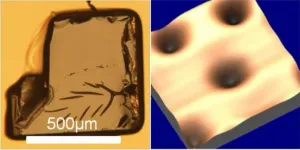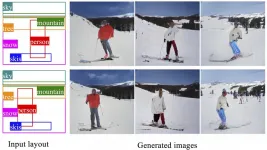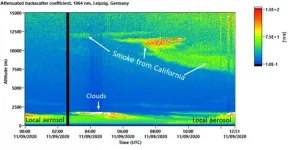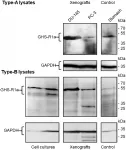(Press-News.org) Hydrogen peroxide (H2O2) is used to disinfect minor cuts at home and for oxidative reactions in industrial manufacturing. Now, the pandemic has further fueled demand for this chemical and its antiseptic properties. While affordable at the grocery store, H2O2 is actually difficult and expensive to manufacture at scale.
A team led by the University of Illinois Urbana-Champaign has demonstrated a more efficient and environmentally friendly method to produce H2O2, according to a recent study published in the Journal of the American Chemical Society.
"While the two ingredients--hydrogen and oxygen--are either inexpensive or freely available from the atmosphere, hydrogen peroxide is highly reactive and unstable, which makes it very hard to produce," said first author Tomas Ricciardulli, a graduate student in chemical and biomolecular engineering at UIUC.
Currently, producing H2O2 requires a complicated, multi-step process and large facilities. Moreso, this traditional method relies on an intermediate chemical (anthraquinone) that is derived from fossil fuels.
Decades ago, researchers proposed a simpler, cheaper, and 'greener' one-step alternative method where a catalyst (palladium-gold nanoparticles) drives the reaction instead. Bonus: the catalyst can be recycled to produce hydrogen peroxide over and over.
"However, hydrogen and oxygen also form water, and this proposed 'direct synthesis' method was known to synthesize 80 percent water and just 20 percent hydrogen peroxide," said lead author David Flaherty, a professor of chemical and biomolecular engineering at UIUC. "Scientists have fiercely debated the arrangement of palladium and gold atoms needed in nanoparticles to increase the selectivity for hydrogen peroxide and why this works."
A higher ratio of gold to palladium atoms in the catalyst produces more H2O2 and less water. The researchers found that a catalyst with a ratio of one palladium to 220 gold atoms generates almost 100 percent hydrogen peroxide, which is about the point of diminishing returns.
Significantly, the catalysts give stable performance over many days of use, continuously achieve these remarkable selectivities to H2O2, and do so using clean water as a solvent, which avoids the problematic and corrosive additives often used for this chemistry.
The organization of these atoms within the catalyst also counts: palladium atoms touching one another favor water formation, while palladium atoms surrounded by gold favor H2O2 formation.
What's more, they discovered the influence extends from the first ring of neighboring atoms that surround the palladium atom to the second layer of atoms, called the next nearest neighbors. More H2O2 is synthesized when both a given palladium atom's neighbors and next-nearest neighbors are all gold.
"We demonstrated how to create a very efficient and selective catalyst," said Flaherty, who is also a Dow Chemical Company Faculty Scholar. "While promising, there are still hurdles to overcome to adopt this method commercially."
The Flaherty research group is pursuing the development of nanoparticle catalysts with new compositions and reactors to enable hybrid chemical-electrochemical methods for this reaction. "Our ultimate goal is to develop feasible technology for distributed production of H2O2 which would open doors for many sustainable alternatives to traditional chemical processes."
The researchers also expect that their activities will reveal other key scientific concepts to electrify chemical manufacturing along the way.
INFORMATION:
The National Science Foundation and the Energy & Biosciences Institute supported this research, which was conducted in part at the Material Research Laboratory at Illinois and the Synchrotron Radiation Facility at Stanford University. Co-authors also included Coogan Thompson and Ayman M. Karim (Virginia Polytechnic Institute and State University), Sahithi Gorthy and Matthew Neurock (University of Minnesota), and Jason S. Adams (UIUC).
TAMPA, Fla. - Moffitt Cancer Center, a national leader in cancer care and research and the only National Cancer Institute-designated Comprehensive Cancer Center based in Florida, is presenting new data from dozens of clinical research studies at this year's American Society of Clinical Oncology (ASCO) Annual Meeting, the world's largest clinical cancer research meeting. Moffitt investigators will lead 25 abstract presentations, five education sessions, two cancer-based panels and two clinical science symposia. The virtual meeting is June 4-8.
Highlights include:
Oral Presentations:
Dr. Bijal Shah will ...
Physicists at the University of Bath in the UK, in collaboration with researchers from the USA, have uncovered a new mechanism for enabling magnetism and superconductivity to co-exist in the same material. Until now, scientists could only guess how this unusual coexistence might be possible. The discovery could lead to applications in green energy technologies and in the development of superconducting devices, such as next-generation computer hardware.
As a rule, superconductivity (the ability of a material to pass an electrical current with perfect efficiency) and magnetism (seen at work in fridge magnets) make poor bedfellows because the alignment of the tiny electronic magnetic particles in ferromagnets ...
A catastrophic drop in atmospheric ozone levels around the tropics is likely to have contributed to a bottleneck in the human population around 60 to 100,000 years ago, an international research team has suggested. The ozone loss, triggered by the eruption of the Toba supervolcano located in present-day Indonesia, might solve an evolutionary puzzle that scientists have been debating for decades.
"Toba has long been posited as a cause of the bottleneck, but initial investigations into the climate variables of temperature and precipitation provided no concrete ...
In interstellar dust clouds, turbulence must first dissipate before a star can form through gravity. A German-French research team has now discovered that the kinetic energy of the turbulence comes to rest in a space that is very small on cosmic scales, ranging from one to several light-years in extent. The group also arrived at new results in the mathematical method: Previously, the turbulent structure of the interstellar medium was described as self-similar - or fractal. The researchers found that it is not enough to describe the structure mathematically as a single fractal, a self-similar structure as known from the Mandelbrot set. Instead, they added several different fractals, so-called multifractals. The new methods can thus be used to resolve ...
Researchers from North Carolina State University have developed a new state-of-the-art method for controlling how artificial intelligence (AI) systems create images. The work has applications for fields from autonomous robotics to AI training.
At issue is a type of AI task called conditional image generation, in which AI systems create images that meet a specific set of conditions. For example, a system could be trained to create original images of cats or dogs, depending on which animal the user requested. More recent techniques have built on this to incorporate conditions regarding an image layout. This allows users to specify which types of objects they want to appear in particular places on the screen. ...
Amsterdam, June 1, 2021 - The Treatabolome project is a research initiative to develop a freely available, interoperable online platform dedicated to disseminating rare disease and gene-specific treatment information to healthcare professionals regardless of their level of specialized expertise. Developed under the Solve-RD European Research Project, it is intended to reduce treatment delays for patients with rare diseases by directly linking diagnosis and treatment information. This initiative is highly relevant to neuromuscular disorders as they are rare diseases by definition. In this special issue of the Journal of Neuromuscular Diseases, experts contribute Treatabolome-feeding systematic literature reviews on rare neurological ...
Neutrons - Space ice, un-Earthly cold
Researchers from NASA's Jet Propulsion Laboratory and Oak Ridge National Laboratory successfully created amorphous ice, similar to ice in interstellar space and on icy worlds in our solar system. They documented that its disordered atomic behavior is unlike any ice on Earth.
The findings could help interpret data from future NASA missions such as Europa Clipper, which will assess the habitability of Jupiter's moon, Europa.
Using the Spallation Neutron Source's SNAP instrument, the scientists replicated the cold vacuum of space and added a few molecules ...
Single atomic defect is the smallest structural unit of solid material. The construction of devices based on single defect can reach the limit of miniaturization of semiconductor devices. In the past decades, the creation and manipulation of single defects in semiconductors opened a new research field, and could be used to physically realize "qubits" of solid-state quantum computation through spin or electron charge. Most interest have focused on the studies of spin quantum computing. However, the spin manipulation need an optical and magnetic field. On the contrary, multiple ...
Leipzig. The smoke from the extreme forest fires on the US West Coast in September 2020 travelled over many thousands of kilometres to Central Europe, where it continued to affect the atmosphere for days afterwards. A comparison of ground and satellite measurements now shows: The forest fire aerosol disturbed the free troposphere over Leipzig in Germany as never before. An evaluation by an international research team led by the Leibniz Institute for Tropospheric Research (TROPOS) revealed an extraordinary optical thickness on 11 September 2020, which attenuated ...
Oncotarget published "Development of a ghrelin receptor inverse agonist for positron emission tomograph" which reported that imaging of Ghrelin receptors in vivo provides unique potential to gain deeper understanding on Ghrelin and its receptors in health and disease, in particular, in cancer.
Ghrelin, an octanoylated 28-mer peptide hormone, activates the constitutively active growth hormone secretagogue receptor type 1a with nanomolar activity.
The authors developed novel compounds, derived from the potent inverse agonist K- -FwLL-NH2 but structurally varied by lysine conjugation ...
